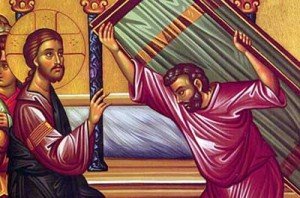History tells us that in several of his sermons Chrysostom reproached his congregation for their lack of attention during the readings. People, it seems complained that there was no point in listening, the reading were always the same. He reminded them that it is God himself who speaks to us through the prophet and the apostle, and still more through the Gospel.
He seems to have had no such problem with his homily or sermon. In fact he reproached those who saw no point in coming to church unless there was to be a sermon. In practice there were often several sermons at the Eucharist at this time. Even though Chrysostom himself occasionally preached for two hours, his sermon came sometimes after that of one or more bishops or priests (I can only imagine what would happen if I gave a two hour sermon). He always preached last as the senior bishop. The homily was preceded by the bishop’s greeting, Peace be with you all, and its response. It was usually delivered from the throne in the apse (the altar), the bishop seated (the pope still delivers his sermons in this manner), the people standing. When Chrysostom preached from the ambon, a chair was not doubt placed for him there. The custom of preaching or teaching from a chair was in all probability continued from Jewish practice in the synagogue. Jesus is said to have sat down to teach, and early Christian art showed him seated in the midst of his disciples, teaching. In the early Church continuity of apostolic teaching from the same chair was an important aspect of apostolic succession.
Not even a preacher of Chrysostom’s eloquence was always heard attentively. He had cause to complain of those who cracked jokes and laughed during the sermon, and did not stop laughing even when the prayers began. On the other hand his sermons, like those of other popular preachers, were often interrupted by applause. The prayers took the form of litanies of the kind we have noticed in the Clementine Liturgy. In all probability the catechumens (those learning and faith and preparing for Baptism), were first prayed for and dismissed, then the penitents (public sinners, penitents, could only stay for part of the service until they were readmitted by a priest). This latter group certainly formed a recognizable group in the Church, for Chrysostom remarked that people were often more ashamed of being recognized as sinner than of having committed the sin itself.
You will recall that there were only a few major acts (sins) that qualified you as a penitent). This all gives us a different view of the early Church.
Христос Воскрес!




